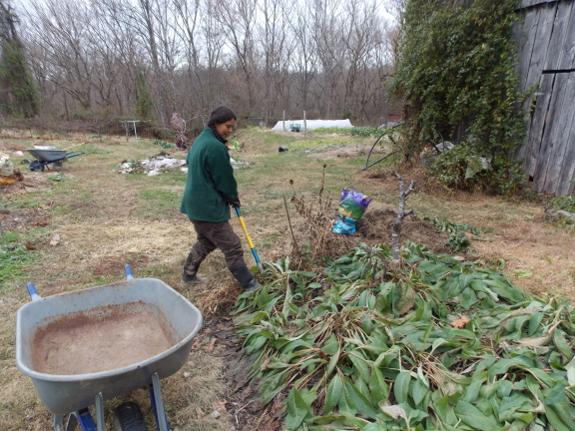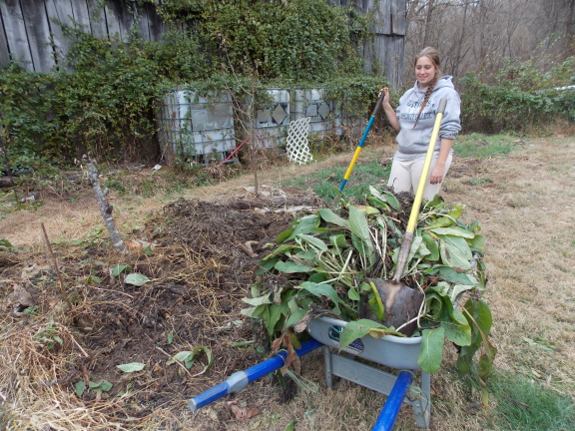
The power of comfrey

See the comfrey bed above? I dug out every single root I could find from that spot last year,
broke the plants up into smaller segments and stuck them into the
ground elsewhere with no water or care. Not only did all the new
starts thrive, the bed now appears to be just as full as comfrey as it
was before I dug the plants out. Time to do it all again!

While I'm on the subject,
I thought comfrey transplanting day would be a good time to regale you
with the comfrey dos and don'ts I've learned over the years:
Comfrey dos:
- Do use comfrey medicinally as a poultice.
I once cut my foot wide open running barefoot amid glass. The
wound really should have had stitches, but Mom gave me a comfrey
poultice, and it healed right up in no time.
 Do plant comfrey in pastures.
Although the mature leaves are not their favorite food, chickens will
eat comfrey if you accidentally let the pasture get overgrazed. The birds also enjoy young comfrey leaves even when they have other options. Best of all, comfrey plants are so hardy even chickens can't kill them.
Do plant comfrey in pastures.
Although the mature leaves are not their favorite food, chickens will
eat comfrey if you accidentally let the pasture get overgrazed. The birds also enjoy young comfrey leaves even when they have other options. Best of all, comfrey plants are so hardy even chickens can't kill them.- Do plant comfrey beyond the eventual spread of your fruit trees. I've started lining paths in the forest garden with comfrey. I can cut the leaves and use them as nutrient-rich mulch, and as long as the comfrey isn't close to my trees, they don't compete much for nitrogen.
- Do start a comfrey nursery bed. Within a couple of years, one plant can turn into dozens of plants that are ultra-easy to move elsewhere.
Comfrey don'ts:
 Don't take comfrey internally. According to some sources, comfrey can be a carcinogen, so I figure it's better not to risk it.
Don't take comfrey internally. According to some sources, comfrey can be a carcinogen, so I figure it's better not to risk it.- Don't put a comfrey poultice on an infected wound. Comfrey makes your skin grow back over a cut so quickly that it can seal infections in, so wash that wound well first!
- Don't plant comfrey within the root zone of young fruit trees. If you have awesome soil, you might get away with this, but comfrey stole nitrogen from my fruit trees and caused their leaves to yellow. Comfrey didn't seem to cause problems in the deeper shade beneath a mature peach, though.
- Don't expect to ever plant anything else where your comfrey is now. Comfrey doesn't run like mint (although it will slowly spread to each side over the years), but it is just as tough to eradicate. So, think hard about what you want to have in that spot in twenty years before putting in your comfrey.
- Don't mulch with comfrey stems. Leaves make a great mulch, but the stems can root and
start a new comfrey patch where you don't want one. Similarly, you
won't want to let even a tiny root end up in your compost pile or the
soil will be full of comfrey plants.
Anything else you'd add to my comfrey instruction sheet?
Want more in-depth information? Browse through our books.
Or explore more posts by date or by subject.
About us: Anna Hess and Mark Hamilton spent over a decade living self-sufficiently in the mountains of Virginia before moving north to start over from scratch in the foothills of Ohio. They've experimented with permaculture, no-till gardening, trailersteading, home-based microbusinesses and much more, writing about their adventures in both blogs and books.
Want to be notified when new comments are posted on this page? Click on the RSS button after you add a comment to subscribe to the comment feed, or simply check the box beside "email replies to me" while writing your comment.

hi there~~ those roots make a wonderful infused oil for aching, sore, bruised muscles . . . . i use it in place of arnica. the infused leaf oil also makes for a great soothing component in healing salves for scrapes, itchy skin, burns. take a peek at what susun weed has to say about drinking comfrey leaf tea internally . . . http://www.susunweed.com/herbal_ezine/June08/wisewoman.htm blessings~~
The Comfrey root and young leaves "may" be toxic in large doses so a poultice is recommended.
Mature leaves are and have been used internally since ancient times.
I recommend some further research into this subject. It can be life saving along with Poke Root. Which is totally a "poisonous" substance according to big pharma and the like. The assault against Herbs is astounding but they can not have such medicines interfering with their profits.
Chemical drugs are far more poisonous than Herbs. It takes study to understand Herbs and their dosages. Small amounts of Poke Tincture can eliminate arthritis pain. I use it myself.
I would love to have some of your Comfrey Root stock....:o)
Edith
Recommended reading http://www.herballegacy.com/Comfrey.html
I have read Susan Weed but please be advised of her use of spiritual influences associated with witchcraft. To each his own but I believe people should be aware and make discerning judgments. I read her work so this is not an attack. She has some good information.
Edith
Thanks for the tip that now's the time to dig up and move the comfrey (mine looks just like yours...freeze damaged but still some green). But, dang, I started the plot (Bocking 14) to put under my young fruit trees as I thought I had read for a permaculture guild. How do you think it would go if I put it between my currant bushes? The space there is too tight for the riding mower, and I'd love to have something I didn't have to mow. And I'll definitely move some to the meat bird pasture. My ducks love the leaves at any stage.
At the Pennsylvania Association for Sustainable Agriculture conference a few years ago I heard in a talk that using the (less spreading) Bocking 14 as a hedge around your garden beds to keep grass and weeds from crawling in.
I would add that it's important to get the variety that doesn't self seed. We got ours from seed but it only tried to flower twice this years so we just removed the flower stalks. That's good to know about the leaf stalks, I had not read that in the past.
Thanks for the info.